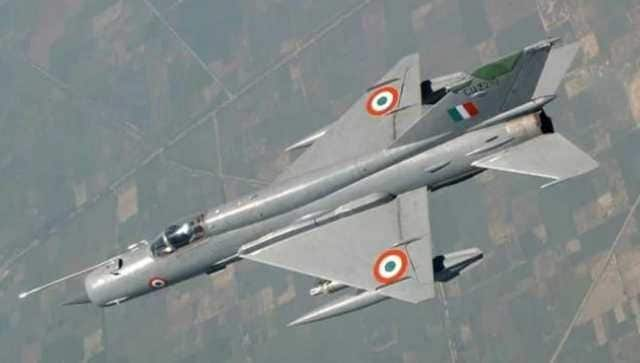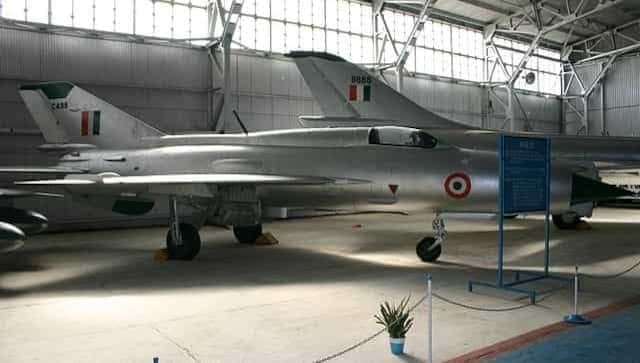Music Video That Were Supposed to Be Continued Party Lub
The Indian Air Force (IAF) is retiring the Srinagar-based MIG-21 squadron, of which Abhinandan Varthaman was a part, today.
The squadron, also known as 'Sword Arms', was part of the operation to repulse Pakistan's retaliatory action on 27 February, 2019, a day after India's Balakot air strike.
Varthaman, who downed an enemy jet during the aerial combat, was later conferred with the Vir Chakra award by then president Ram Nath Kovind. Varthaman.
He is now a Group Captain.
Let's take a closer look at the history of 'Sword Arms' and why the IAF is retiring the squadron:
'Sword Arms'
Raised in Chandigarh on 1 February, 1985, the No 51 squadron moved to its present location Srinagar on 1 May, 1986. "
An IAF official told The Tribune the squadron will be 'number plated' (referring to the retirement of a squadron that generally comprises 17-20 aircraft) and that it would be revived once new jets arrived.
The squadron has been part of many successful missions.
In 1987, Operation Brasstacks saw its pilots flying from both Srinagar and Awantipora, as per The Tribune.
'Operation Safed Sagar' during the Kargil conflict in 1999 saw the squadron fly 194 sorties and offensive missions at Point 5140 and Tololing in the first two days of the operation, as per the newspaper.
And of course, the famous operation to repulse Pakistan's retaliatory action on 27 February, 2019, a day after India's air strike in Balakot inside the neighbouring country, which saw Varthaman shoot down a Pakistani F-16 combat aircraft during a dogfight.
India's response came after Pulwama suicide attack in Kashmir in which 40 Central Reserve Police Force (CRPF) personnel were killed on 14 February, 2019.
Part of 'modernisation drive', says IAF
This move comes as part of the IAF's overall plans to phase out the MIG-21 by 2025.
"The 51 Squadron based out of Srinagar air base is being number plated on 30 September. After this, only three squadrons of the planes would be left in service and would be phased out by the year 2025," news agency ANI quoted IAF as saying on Friday.
One squadron of each of these planes would be number plated every year, officials told DNA.
In July, people familiar with the matter told PTI that the IAF had drawn up a three-year timeline to phase out the remaining four MIG-21 fighter squadrons as part of a 'modernisation drive.'
The IAF currently around 70 MIG-21 aircraft and 50 MIG-29 variants.
"We are also planning to retire the MIG-29 fleet and the process will start in next five years," an official said.

File image of a MiG-21 Bison aircraft. Image courtesy: News18
To help the IAF replace its ageing fighter fleet, the defence ministry in February last year sealed a ₹48,000 crore deal with the Hindustan Aeronautics Ltd (HAL) for the procurement of 83 Tejas fighter aircraft.
The IAF is also in the process of procuring 114 Multi-Role Fighter Aircraft (MRFA).
A senior official said the IAF will not be able to reach the sanctioned strength of 42 squadrons in the next 10-15 years notwithstanding all the planned acquisitions as a significant number of aircraft are being phased out.
India is also working on an ambitious $5 billion project to develop a fifth-generation medium-weight deep penetration fighter jet to significantly bolster its air power capability.
MIG-21 the IAF mainstay
The MIG variant, which first launched in 1963, has been a mainstay of the IAF for years.
The first fleet of the MIG variant was inducted into the IAF in 1963.
India has procured over 700 MIG-variants in the subsequent decades.
As TJ Reddy writes in Newsmeter.in, "Every experienced fighter controller who controlled these aircraft in an air defence interception role, I can vouch, will agree that it gave immense joy to control them."
Reddy added that the MIG-21 was designed as a high-speed, high-altitude interceptor, working with a ground control interception environment, to shoot down incoming American bombers towards the USSR mainland.
"The way it was supposed to work was like this – after ground radars had identified the American bomber, a ground controller (commonly known as fighter controller), using information available about the enemy and own aircraft, would direct the MIG-21s towards the incoming bomber, placing them in a favourable position to launch their missiles and immediately get away at high speed. Even if the missile attack was not successful (the infra-red technology wasn't too advanced then), it forced the attackers to jettison their payload and abort their missions (as was frequently noticed in Vietnam)."
He added that the MIG-21 carried out a variety of roles in East Pakistan during the 1971 war including providing air support to the army, interdiction, grounding the Pakistan Air Force by rendering the runways unusable and the pin-point accurate rocket attack on the Governor's house at Dhaka that proved to be a turning point and hastening Pakistan's surrender.

MiG-21 at Indian Air Force Museum, Palam.
Reddy wrote that the MIG-21 was later adapted for high altitude mountaintop attacks in the Kargil operations and that it provided 'unmatched flexibility' due to its unique attributes of high agility, fast acceleration and quick turn-around.
"It is MIG-21 again which downed Pakistan Navy Atlantique when it violated the Indian airspace in 1999, scrambled and closely controlled by a Fighter Controller,
Reddy added in Newsmeter.in.
Spotty safety record
However, of late, the safety record of the MIG-21 has been spotty.
Officials told DNA the MIG-21s were supposed to be retired 'a long time ago' but that the IAF was forced to continue flying these planes due to delays in inducting the LCA Tejas craft.
The IAF carries out extensive checks on these planes before flying and all safety aspects are taken care of before the pilot takes off, officials added.
Newsable quoted officials as saying more MIG-21s have crashed than any other fighter jets because they formed the bulk of the combat aircraft in the IAF's inventory for a long time.
In July, a MIG-21 crash in Rajasthan's Barmer killed its pilots Wing Commander M Rana and Flight Lieutenant Advitiya Bal, an incident that yet again spotlighted the ageing fleet.
Defence minister Rajnath Singh spoke to Air Chief Marshal VR Chaudhari following the crash and expressed his condolences.
"Deeply anguished by the loss of two Air Warriors due to an accident of IAF's Mig-21 trainer aircraft near Barmer in Rajasthan," Singh said on Twitter.
"Their service to the nation will never be forgotten. My thoughts are with the bereaved families in this hour of sadness," he said.
However, officials insisted that the modernisation move has nothing to do with the crash.
In March, Minister of State for Defence Ajay Bhat told the Rajya Sabha that 42 defence personnel were killed in accidents involving aircraft and helicopters of the three services in the last five years.
The total number of air accidents in the last five years was 45 out of which 29 involved IAF's platforms.
With inputs from agencies
Read all theLatest News,Trending News,Cricket News,Bollywood News,
India News andEntertainment News here. Follow us on Facebook, Twitter and Instagram.
Source: https://www.firstpost.com/explainers/explained-why-iaf-is-retiring-abhinandan-varthamans-mig-21-squadron-that-took-on-pakistan-11286091.html
0 Response to "Music Video That Were Supposed to Be Continued Party Lub"
Post a Comment